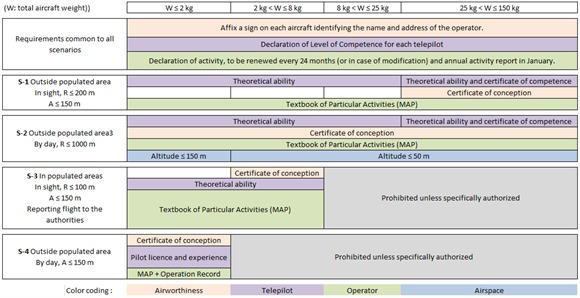Regulatory environment
To date, we list the main regulations required to operate a drone in a commercial context. Note that these rules evolve quickly, as new fields open every day and the pressure for more freedom from operators on the regulators is always there.
Four drone flying operation scenarios are envisaged for now:
- S-1: operations with direct sight of the drone, outside a populated zone, at a maximum distance of 200m from the pilot.
- S-2: operations out of sight, outside a populated zone, at a maximum distance of 1km from the pilot and below an altitude of 50m. No one is allowed within the operating zone.
- S-3: operations in a populated area or near persons/animals, in direct sight and at a maximum distance of 100m from the pilot.
- S-4: special operations (view shooting, observations, plotting, aerial surveillance…) out of sight, outside a populated zone and not corresponding to S-2.
The last scenario is of most importance, indeed it makes France one of the few countries having regulated flights with the pilot out of sight.
Among other important points in the current regulations:
- Drone builders have to have their models certified by the DGAC, stipulating the category of drone in which the model falls, the nature of its operations and the scenario in which it will operate.
- The operators have to register on a DGAC list, and have to mention the nature of their operations, the scenarios exploited, as well as the model of drones used and its maker.
- The pilots have to obtain an official certificate (theoretical training) and hold a Statement of Skill Level (DNC).
- Operations have to be allowed by the prefectures via a flight authorisation, solicited by the filing of a Textbook of Particular Activities (MAP).
Summary of requirements applicable to the operator, its aircraft and telepilots according to the DGCA:

R = Range
A = Altitude
These rules are about to be reinforced at the European level, under the supervision of The European Aviation Safety Agency (EASA). The regulatory framework should cover security, safety, privacy, data protection and insurance matters. The EASA has published a first regulation, which should be implemented on 1 January 2021, which will define the categories of UAV operations according to three classes based on their risk.
Open Category: Leisure or professional drone flights of less than 25kg whose flight is made in sight. No permission, authorisation or training will be required. The aircraft will have to meet CE marking standards. Technical standards are currently being developed in Europe.
Specific Category: This category covers characteristics that have not been covered under the ‘open’ category. Under this category, the drone operator has to undergo a safety risk assessment and identify a mitigation structure that needs to be reviewed and approved by the National Aviation Authority (NAA). A Manual of Operations is mandatory to obtain approval.
Certified Category: Includes large unmanned aircraft and their operations, carrying a higher degree of risk (transport of goods, urban logistics and people). It will follow aeronautical principles, such as certification and the need to have a drone pilot’s licence. Its full definition is still pending criteria from EASA.
Transaction on Aerialtronics
Drone Volt bought up the assets of the Aerialtronics company. On 18 September 2017, Drone Volt took majority control of the main assets (including products, inventory and intellectual property, as well as the knowledgeable team members and sites) of the Dutch company, Aerialtronics DV BV.
On 9 September 2020, Drone Volt acquired the remaining shares to the minorities, or 49.8% of the market capitalisation. The operation was based on a $5.95 valuation, or €5m, financed with a vendor loan over 36 months, carrying 3% interest.